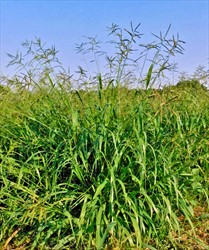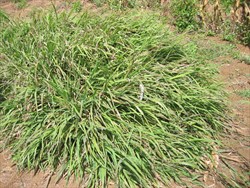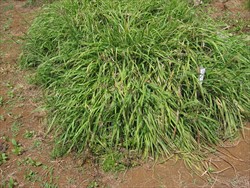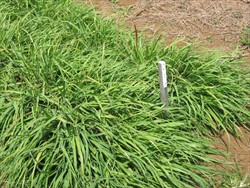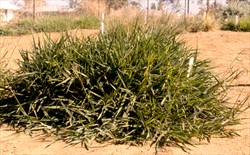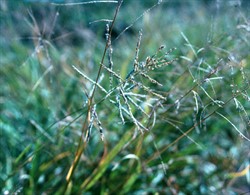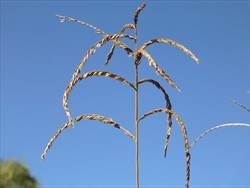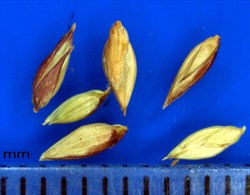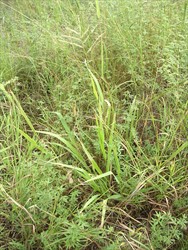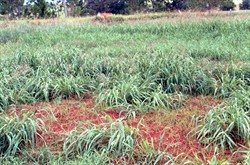Urochloa oligotricha
Tropical Forages
Urochloa oligotricha (Fig. & De Not.) Henrard
Basionym: Panicum oligotrichum Fig. & De Not.; Helopus bolbodes Hochst. ex Steud.; Urochloa bolbodes (Hochst. ex Steud.) Stapf
Family: Poaceae (alt. Gramineae) subfamily: Panicoideae tribe: Paniceae subtribe: Melinidinae.
Tufted perennial; short stout rhizomes and variable stolon development (<U. mosambicensis); foliage 30–60 cm and fertile culms 60–120 cm tall; silky tomentose, sometimes bulbous, at the base. Leaf blades linear, 10–40 cm long, 5–20 mm wide. Inflorescence comprising (2–) 6–20 racemes spreading, on a finely-hairy common axis 5–10 cm long; racemes 3–10 cm long, bearing mostly paired spikelets on a subtriquetrous rachis, the latter with or without bristles. Spikelets lanceolate to narrowly ovate, 3.5–6 mm long, glabrous, pubescent or setosely fringed, acuminate; lower glume lanceolate, 5 (–7)-nerved, membranous to herbaceous, mostly ⅔–¾ the length of the spikelet, without a central tuft of bristles, narrowly obtuse to acute; upper glume glabrous or pubescent; lower lemma sometimes with a setose fringe; upper lemma granulose to rugulose, with an awn 0.3–1 mm long. 900,000–1.2 million seeds per kg.
Similar species
U. oligotricha: perennial; lower glume 5-nerved, without median bristles, spikelets lanceolate; basal sheaths densely hairy; plants rhizomatous.
U. mosambicensis: perennial; lower glume 3-nerved, with 0 - 3 median bristles; tufted or stoloniferous
U. brachyura: annual, lower glume 5-nerved, without median bristles, the tip narrowly rounded
U. trichopus: annual; lower glume 3-nerved, the middle nerve with 1–5 median bristles; tip broadly rounded or truncate; tufted grass
Africa: beesgras, meerjarige beesgras, meerjarige urochloa (Afrikaans); phuka(-si) (Ju|’hoan, Namibia)
German: ausdauerndes Fettweidegras (Namibia)
English: dubi grass, gonya grass, perennial signal grass, perennial tail grass
Native:
Africa: Angola; Botswana; Democratic Republic of the Congo; Eritrea; Ethiopia; Kenya; Malawi; Namibia; South Africa; Sudan; Swaziland; Tanzania; Uganda; Zambia; Zimbabwe
Forage
Main application as a rapidly establishing, short or long term pasture.
Environment
Not as good as U. mosambicensis for ground cover/erosion control.
Soil requirements
Occurs over a range of soil textures from sands to clays, although more commonly on light to medium textured soils of pH (6.0–) 6.5–7.5 (–8.5). Found in both well and poorly drained soils.
Moisture
U. oligotricha is largely from areas of annual rainfall, (400–) 600–1,000 (–3,750) mm. While often found in moist shady places, it is drought tolerant with many accessions originating from the drier extremes of semi-arid environments. It is sometimes found in wet areas (not swamps), but there is no record of its reaction to inundation.
Temperature
U. oligotricha occurs naturally from about 14º N (Sudan) to 25º S (South Africa), and from 300 to 2,000 m asl, areas mostly with an average annual temperature ±20 ºC (>27 ºC in the Sudan). It makes most growth in summer, but responds to out-of-season rains. Leaves are burnt off by frost, but plants recover with onset of warmer, moist conditions.
Light
Often occurring in savanna woodland, it has at least moderate shade tolerance. However, it is also found in more open situations along roadsides and as a weed in old farmland.
Reproductive development
As with U. mosambicensis, many accessions appear to be day neutral, flowering through much of the growing season. However, some mature earlier than others, some much later, suggesting some degree of day length sensitivity and possible interaction with temperature.
Defoliation
It is selectively grazed and can be grazed out in more intensive systems.
Fire
Density is favoured by annual burning.
Guidelines for establishment and management of sown forages.
Establishment
Seed dormancy does not seem to be as pronounced as it is in U. mosambicensis. U. oligotricha is best established by drilling or broadcasting seed at 1–3 kg/ha into a well-prepared seedbed. It is preferable to roll afterwards. Seedlings establish quickly, so establishment is also possible into a “rough” seedbed.
Fertilizer
It responds well to nitrogen on less fertile soils. Other nutrients, particularly P and K, should be monitored and maintained as required. Despite growing naturally on soils with low available phosphorus, large responses to applied P have been measured. On very low fertility soils, applications of up to 30–60 kg/ha of P may be necessary, depending on genotype, to maximise production. A critical P level in the tissue of 0.2–0.3 % of the DM is proposed.
Compatibility (with other species)
U. oligotricha is not an aggressive species and can be grown successfully with legumes and other grasses.
Companion species
Grasses: Urochloa mosambicensis.
Legumes: Chamaecrista rotundifolia, Desmanthus spp., Stylosanthes hamata, S. humilis, S. scabra.
Pests and diseases
While a number of fungal diseases such as tar spot caused by Phyllachora setariicola, smut caused by Sorosporium afrum and rust caused by Uromyces setariae-italicae have been identified in Africa, they do not have a major impact on productivity.
Ability to spread
It primarily spreads by seed, less readily than U. mosambicensis, and more so than Cenchrus ciliaris.
Weed potential
U. oligotricha does not appear to pose the same weed threat as do U. mosambicensis and U. panicoides. However, it is included in weed lists in various parts of the tropics and subtropics.
Nutritive value
As with U. mosambicensis, crude protein content of the first fully expanded green leaf on a plant can fall from about 15% to a little over 4% in 4 weeks, with P levels showing a similar rate of decline. P levels in tops can vary from 0.15–0.65% depending on P fertility of the soil.
Palatability/acceptability
Very palatable and sought after by domestic livestock and wildlife.
Toxicity
No record of toxicity.
Feedipedia link
April 2020: Page under construction
Dry matter
In the seasonally dry tropics, U. oligotricha has produced DM yields of 6 t/ha compared with 16 t/ha from Urochloa decumbens, and 1.5–4 t/ha when U. mosambicensis produced 5–7 t/ha. Higher yields have been obtained in more humid tropics. Many yield comparisons are drawn from single genotype comparisons and do not necessarily reflect species differences.
Animal production
No information available.
Apomictic, 2n = 36.
Experimental seed has been relatively easily produced using a conventional approach to tropical grass seed production.
U. oligotricha has not attracted the level of research that it perhaps warrants. Consequently, any information is usually limited to one or few accessions, and herbicide screening has not been considered a priority. The only specific information found is that U. oligotricha CPI 47122 "is not very susceptible to the pre-emergence herbicide atrazine."
- Rapid establishment.
- Fast regrowth.
- Very palatable with high utilisation.
- Adapted to low rainfall.
- Widely adapted (including alkaline soils).
- Compatible with legumes
.
- Intolerant of heavy grazing.
- High palatability leads to overgrazing and stand decline.
- May not suit cracking clays.
- Little researched.
Bogdan, A.V. (1977) Tropical Pasture and Fodder Plants. Longman Inc., New York, USA. p.294–295.
Burt, R.L., Sinclair, D.F., Harrison, P., Pengelly, B.C. and Williams, W.T. (1980) Preliminary agronomic evaluation of some perennial Urochloa species over a range of environments. Australian Journal of Experimental Agriculture and Animal Husbandry 20:439–446. doi.org/10.1071/EA9800439
Burt, R.L., Williams, W.T., Gillard, P. and Pengelly, B.C. (1980) Variation within and between some perennial Urochloa species. Australian Journal of Botany 28:343–356. doi.org/10.1071/BT9800343
Clayton, W.D. and Renvoize, S.A. (1982) Gramineae (Part 3). In: Polhill, R.M. (ed) Flora of tropical East Africa. Royal Botanic Gardens, Kew, UK.
McIvor, J.G. (1984) Effects of phosphorus and superphosphate on the growth of Urochloa species. Australian Journal of Experimental Agriculture and Animal Husbandry 24:571–578. doi.org/10.1071/EA9840571
McIvor, J.G. (1984) Leaf growth and senescence in Urochloa mosambicensis and U. oligotricha in a seasonally dry tropical environment. Australian Journal of Agricultural Research 35:177–187. doi.org/10.1071/AR9840177
Pengelly, B.C.and Eagles, D.A. (1999) Agronomic variation in a collection of perennial Urochloa spp. and its relationship to site of collection. Genetic Resources Communication No. 29. CSIRO Tropical Agriculture, St Lucia, Australia. bit.ly/2wQJ89A
Silcock, R.G., Finlay, C.H., Loch, D.S. and Harvey, G.L. (2015) Perennial pastures for marginal farming country in southern Queensland. 2. Potential new grass cultivar evaluation. Tropical Grasslands-Forrajes Tropicales 3:15−26. doi.org/10.17138/tgft(3)15-26
Torres González, A.M. and Morton, C.M. (2005) Molecular and morphological phylogenetic analysis of Brachiaria and Urochloa (Poaceae). Molecular Phylogenetics and Evolution 37:36–44. doi.org/10.1016/j.ympev.2005.06.003
Whiteman, P.C. and Gillard, P. (1971) Species of Urochloa as pasture plants. Herbage Abstracts 41:351–357.
None released to date.
The following accessions have shown merit in Queensland, Australia:
CPI 47122 Origin Outjo, Namibia (20º S, 1,200 m asl, rainfall 500 mm). Tall tussocky type with few or no stolons, performing well over a range of sites in the seasonally dry tropics.
CPI 47129 Origin Outjo, Namibia (20º S, 1,000 m asl, rainfall 700 mm). Tall tussocky type with high stolon numbers, performing well over a range of sites in the seasonally dry tropics. High yielding and late flowering; potentially suitable for perennial forage cropping.
CPI 60122 Origin Zambia (17º S, 1,240 m asl, rainfall 700 mm). Tall type with few stolons. Performed well in the sub-humid subtropics.
CPI 60123 Origin Zimbabwe (18º S, 790 m asl, rainfall 550 mm). Medium type with stolons. Performed well in the sub-humid subtropics.
